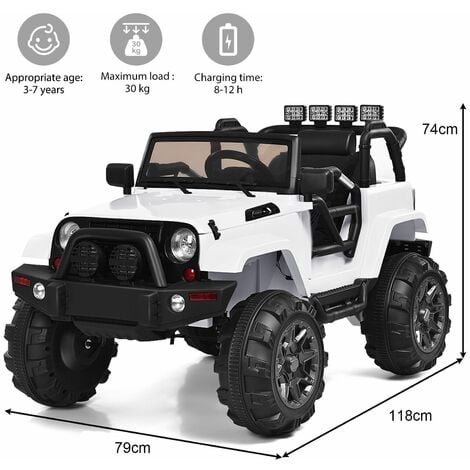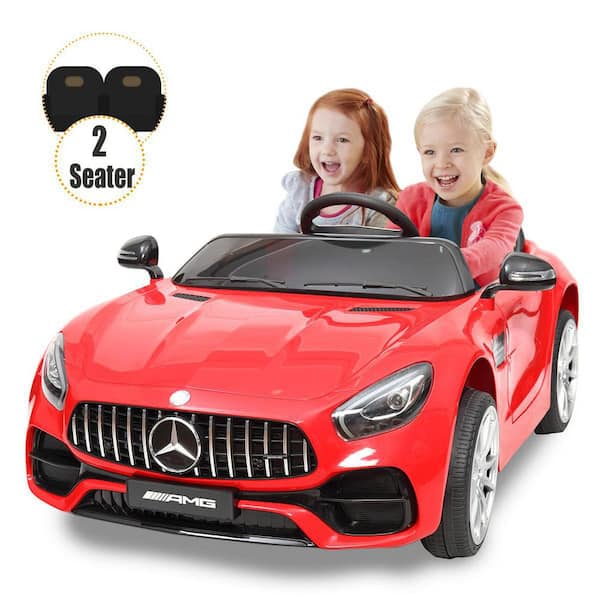Excellent Advice On Choosing Electric Kids Cars
Excellent Advice On Choosing Electric Kids Cars
Blog Article
What Are The Safety Features That I Should Consider When Buying A Ride On Car? Cons And Pros
If you are considering a ride-on automobile for your child, safety features are paramount to ensure their safety when they play. Here are some important safety features to think about, along with their pros and cons - Seat Belts -
Pros: Seat belts are an excellent method to keep your child secure in the car they ride in. They decrease the likelihood of him slipping out during play or being removed from the car. They provide an extra layer of safety particularly when taking rapid turns or stopping abruptly.
Cons - Certain vehicles for ride-ons specifically designed for children, particularly toddlers, do not come with seat belts. Children may also find the seat belts to be uncomfortable or restricting which can cause them to reject or resist using them.
Sturdy Construction -
Pros: A sturdy ride-on vehicle with high-quality materials will last longer and be less likely to break. This will ensure the safety and security of your children. It can stand up to the demands of playtime, and provides stability when it is used.
Cons - Sturdy design usually comes at a higher price point, making it more expensive for certain families. The more heavy materials used could hinder the maneuverability and mobility.
Low Center of Gravity
Pros-Ride-ons with an elongated center of gravity will be less likely to tip over, which reduces the chance of accidents. They are more stable and provide better control during turns and maneuvers.
Cons - Some rides-on-cars with low centers of gravity can sacrifice their off-road ability or their ground clearance. This limits their versatility in certain environments.
Remote Control for Parents -
Pros - Parents can supervise their children's play activities and provide assistance, while ensuring safety and security. Parents can intervene in case of emergency, navigate difficult terrain, or prevent collisions.
Cons – Parental remote control can limit children’s autonomy and independence, as they heavily rely on the supervision of their parents and help in playing. Additionally, remote-controlled models may be more expensive than ride-on vehicles that are manual.
Speed Limiters
Pros - Ride-on vehicles with speed limiters or adjustable speed settings permit parents to regulate the maximum speed of the car and reduce the chance of collisions or accidents. They are able to increase the maximum speed as their child's confidence improves.
Cons – Some children will get bored with lower speed settings that can result in disappointment and frustration. Also, speed limiters might not be available on all models or may require additional features or accessories.
Safe Start Technology -
Pros - The ride-on car is designed to start and stop with ease. It reduces the chance that the child could be scared or unstable. It offers a more comfortable and safer riding experience.
Cons - Models that include the safe start feature might cost more than those without. In addition, some kids may find the gradual acceleration or deceleration to be less thrilling or exciting than quick stops and starts.
Visibility Enhancements
Pros- Ride-on-cars with visibility enhancements including functioning headlights (or taillights) reflective material or other options increase visibility. This is helpful in dim or low-light environments. These vehicles improve safety because they make the vehicle more easily visible to other pedestrians or vehicles.
Cons – The addition of visibility features may add battery consumption or increase the complexity within the design of the ride-on car. These factors can cause problems or maintenance problems.
If you take a look at these safety features and weighing their advantages and disadvantages, you can select a ride-on car that prioritizes your child's safety while providing a fun and enjoyable play experience. Take a look at the best Mercedes ride on car for site examples including electric toy car, childrens electric cars, toy ride, toy car, remote control childrens car, riding digger, childrens digger, car on ride, ride a toy, race car toy and more. . 
What Kind Of Maintenance And Assembly Requirements Exist For Kids' Rides On Automobiles?
To ensure durability and safety, most kid's ride-on vehicles require assembly. Here are the common assembly and maintenance requirements for kid's ride-on cars - - Assembly -
The majority of cars that ride on arrive partially assembled and need some assembly. It usually involves attaching components such as the seats and steering wheel according to the instructions of the manufacturer.
Follow the assembly instructions carefully, making sure all parts are securely connected and properly aligned. Make use of the tools and hardware to complete the assembly.
Cleaning -
For the ride on car to appear its best and perform effectively, regular cleaning is essential. Use a soft sponge, or cloth soaked in water and mild soap to wash the exterior surfaces.
Pay attention to places that are prone to accumulation, such as the wheels, tire, and undercarriage. To clean stubborn dirt and grime brush or a brush to get into places that are difficult to reach.
Beware of harsh chemicals and abrasive detergents. They can damage electronic components or paint of your ride-on vehicle.
Battery Care
It is important to take care of the battery in case your vehicle that you ride on is powered by a battery that is able to be recharged. This will allow you to maintain its performance and extend battery life. These guidelines will help you take care of your battery.
Charge the battery before each use, and completely after each use. This ensures that you have the best performance.
Avoid charging batteries excessively or leaving them hooked up to chargers for extended durations. This could damage batteries and decrease their lifespan.
Keep the ride-on vehicle and battery in a cool, dry area when not being used and away from intense sunlight or extreme temperatures.
Inspect the battery terminals regularly for corrosion and damage. Clean them with a terminal cleaner or wire brush when necessary.
Replace the battery if it is no longer in charge or if there are indications of damage.
Tire Maintenance -
Check the tires regularly for signs of damage, wear or loss of air. Inflate the tires according to the recommended pressure by using the bicycle pump or an air compressor if needed.
Check the tread pattern and see if there is any foreign object or other debris which could lead to flats or punctures. Removal of obstructions and replacement of damaged tires or fixing them if required.
Lubricate the wheel bearings and axles frequently to decrease friction and ensure smooth movement.
Occasional repairs or replacements
Even with regular maintenance, it's likely that the ride-on vehicles require repair or replaced with parts due to wear and tears or accidents.
Keep an eye out for indicators of wear or damage for unusual sounds or power loss or an unpredictable behavior. Consult the manufacturer’s instructions or call Customer Support for help troubleshooting.
Replace damaged or worn components immediately to avoid any further damage and ensure the safety of the ride on the vehicle.
Follow these steps to maintain your child's ride-on vehicle and provide hours of fun and safe play time for them. See the top go here for Audi kids car for website info including toy car for car, toy the car, remote control childrens car, toy a car, electric ride on cars, ride of car, two seater childrens electric cars, toy car, toy car, toy car for car and more. . 
What Are The Remote Controls For Children's Cars That Are Available? What Are Some Of The Advantages And Disadvantages?
Remote control cars for children, also known as RC cars or remote-controlled automobiles are available in different dimensions, styles, and price ranges to suit different budgets and tastes. Here's an overview of the kinds, sizes, prices as well as pros and cons of remote controlled children's cars The types of remote control Children's Cars
Electric RC Cars - Battery-powered remote-controlled cars that are suitable for outdoor and indoor use. They are available in different styles such as buggies or trucks.
Nitro RC Cars – Gas powered remote controlled vehicles that offer greater performance but need greater maintenance. They are generally larger and more costly than electric RC car.
Scale Models Remote-controlled replicas of real-life vehicles, including cars, trucks, airplanes, and boats. Scale model sizes range from 1-10 to 1--24. Larger models have more quality and greater real-world realism.
Sizes -
Remotely controlled children's cars come in different dimensions. These range from small miniature replicas to larger-scale replicas. The size of the car could impact its performance, speed and the handling capabilities.
Micro-sized cars are light and compact. They're ideal for young children and indoor use. Larger-scale cars are more robust and durable making them ideal for off-road and outdoor racing.
Prices
Prices vary based on size, features brand and build quality.
Electric and Nitro RC cars in larger scale can cost between $100 and $500.
Scale model cars and high-end hobby RCs can cost anywhere from a few hundred and over a 1,000 dollars, depending on how precise and powerful they are.
Pros & Pros and
Pros -
Entertainment - Remote control children's vehicles provide endless entertainment and fun for both adults and children.
Development of skills The RC car can help children develop their spatial awareness and hand-eye co-ordination.
Social Interaction. RC cars encourage social interaction and be enjoyed by family and friends. relatives.
Aftermarket parts including upgrades, accessories, and other items from the aftermarket can be used to modify numerous RC cars and increase their performance.
Cons
Costs - A car that is remote controlled for children that has advanced features or even hobby quality models can cost quite a bit.
Learning Curve - Controlling an RC car requires practice and expertise, and smaller youngsters may have difficulty with the controls in the beginning.
Maintenance - RC cars need regular maintenance, such as cleaning, lubrication, and occasional repairs or replacements of parts.
Safety Concerns - RC cars can pose dangers to safety, such as collisions, falls, as well as electrical dangers, if operated with caution and under the supervision of an adult. supervision.
Remote control cars for children provide a fascinating learning and entertaining experience. However, it is essential to pick the correct model based on factors like dimensions, safety, price and features. Hobby-grade RC models are suitable for older children or people who enjoy. Simpler models are best for beginners and younger children. Read the recommended ride on toys kidscars.co.uk tips for website tips including kidscars, two seater electric cars, cars pedal car, childrens ride on, race car toy, childrens electric ride on, race car toy car, childs car toy, toy in car, kidscars and more. .